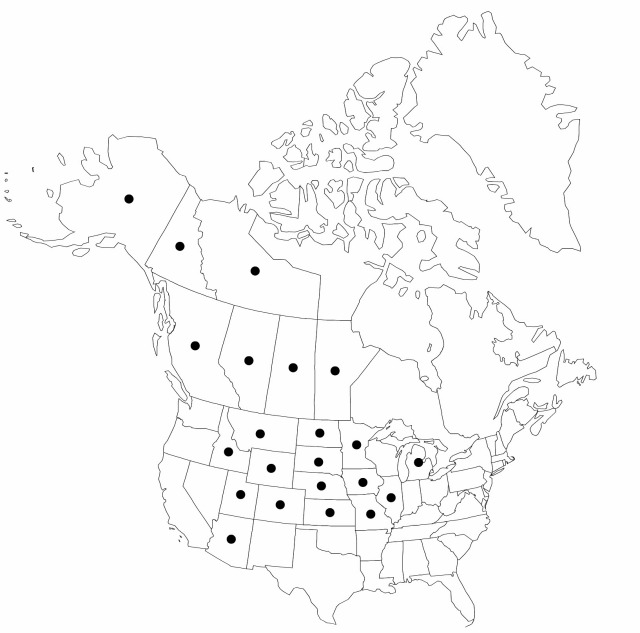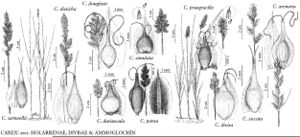Difference between revisions of "Carex duriuscula"
Mém. Acad. Imp. Sci. St.-Pétersbourg Divers Savans 1: 214. 1831.
FNA>Volume Importer |
FNA>Volume Importer |
||
| Line 11: | Line 11: | ||
|name=Carex eleocharis | |name=Carex eleocharis | ||
|authority=L. H. Bailey | |authority=L. H. Bailey | ||
| − | }}{{Treatment/ID/Synonym | + | }} {{Treatment/ID/Synonym |
|name=Carex stenophylla subsp. eleocharis | |name=Carex stenophylla subsp. eleocharis | ||
|authority=(L. H. Bailey) Hultén | |authority=(L. H. Bailey) Hultén | ||
| − | }}{{Treatment/ID/Synonym | + | }} {{Treatment/ID/Synonym |
|name=Carex stenophylla var. eleocharis | |name=Carex stenophylla var. eleocharis | ||
|authority=(L. H. Bailey) Breitung | |authority=(L. H. Bailey) Breitung | ||
| Line 32: | Line 32: | ||
|elevation=300–3300 m | |elevation=300–3300 m | ||
|distribution=Alta.;B.C.;Man.;N.W.T.;Sask.;Yukon;Alaska;Ariz.;Calif.;Colo.;Idaho;Ill.;Iowa;Kans.;Mich.;Minn.;Mo.;Mont.;Nebr.;Nev.;N.Mex.;N.Dak.;Oreg.;S.Dak.;Utah;Wash.;Wyo.;Asia. | |distribution=Alta.;B.C.;Man.;N.W.T.;Sask.;Yukon;Alaska;Ariz.;Calif.;Colo.;Idaho;Ill.;Iowa;Kans.;Mich.;Minn.;Mo.;Mont.;Nebr.;Nev.;N.Mex.;N.Dak.;Oreg.;S.Dak.;Utah;Wash.;Wyo.;Asia. | ||
| − | |discussion=<p>Carex duriuscula belongs to a difficult complex of temperate dry grassland species, and the North American plants are recognized here as conspecific with the Asian Carex duriuscula, following T. V. Egorova (1999). Compared to the Asian plants, the North American plants usually are taller [5–12(–20) versus (6–)10–35 cm] and the perigynia are larger [2.5–3(–3.2) versus 2.4–3.9 mm] (T. V. Egorova 1999). More work is still needed here. North American plants have often been treated as a variety or subspecies of the Eurasian C. stenophylla, which is quite different in having larger perigynia that are distinctly veined adaxially.</p><!-- | + | |discussion=<p><i>Carex duriuscula</i> belongs to a difficult complex of temperate dry grassland species, and the North American plants are recognized here as conspecific with the Asian <i>Carex duriuscula</i>, following T. V. Egorova (1999). Compared to the Asian plants, the North American plants usually are taller [5–12(–20) versus (6–)10–35 cm] and the perigynia are larger [2.5–3(–3.2) versus 2.4–3.9 mm] (T. V. Egorova 1999). More work is still needed here. North American plants have often been treated as a variety or subspecies of the Eurasian C. stenophylla, which is quite different in having larger perigynia that are distinctly veined adaxially.</p><!-- |
--><p>The species is sporadically introduced along roads and in railway yards east of its native range.</p> | --><p>The species is sporadically introduced along roads and in railway yards east of its native range.</p> | ||
|tables= | |tables= | ||
| Line 57: | Line 57: | ||
|publication year=1831 | |publication year=1831 | ||
|special status= | |special status= | ||
| − | |source xml=https://jpend@bitbucket.org/aafc-mbb/fna-data-curation.git/src/ | + | |source xml=https://jpend@bitbucket.org/aafc-mbb/fna-data-curation.git/src/8f726806613d60c220dc4493de13607dd3150896/coarse_grained_fna_xml/V23/V23_529.xml |
|genus=Carex | |genus=Carex | ||
|section=Carex sect. Divisae | |section=Carex sect. Divisae | ||
Revision as of 17:08, 18 September 2019
Rhizomes 0.6–1.8 mm thick, shoots often arising 2–several per cluster, many nodes without shoots. Culms bluntly trigonous, (6–)10–35 cm, smooth-angled distally. Leaves: basal sheaths grayish brown to dark brown, shredding into fibers; sheaths with hyaline inner band, apex not prolonged beyond base of blade; ligules 0–0.8 mm, glabrous; blades 0.6–1.8 mm wide. Inflorescences 0.7–2 cm, 1/2+ as wide as long (if pistillate); spikes 3–8, androgynous, ovoid. Pistillate scales dark reddish brown, with hyaline margins, broadly ovate, 2.4–4.1 mm, apex acute to acuminate, shiny. Anthers 1.4–3 mm, apiculus smooth to warty, very short and broad (30X). Perigynia dark reddish brown, essentially veinless, ± stipitate, broadly ovate to nearly orbicular, thickly plano-convex, 2.4–3.9 × 1.5–2.1 mm, shiny; beak 0.3–0.9 mm, hyaline, weakly bidentulate or oblique.
Phenology: Fruiting Jun–Aug.
Habitat: Dry prairies, sagebrush grasslands, openings in dry forests
Elevation: 300–3300 m
Distribution

Alta., B.C., Man., N.W.T., Sask., Yukon, Alaska, Ariz., Calif., Colo., Idaho, Ill., Iowa, Kans., Mich., Minn., Mo., Mont., Nebr., Nev., N.Mex., N.Dak., Oreg., S.Dak., Utah, Wash., Wyo., Asia.
Discussion
Carex duriuscula belongs to a difficult complex of temperate dry grassland species, and the North American plants are recognized here as conspecific with the Asian Carex duriuscula, following T. V. Egorova (1999). Compared to the Asian plants, the North American plants usually are taller [5–12(–20) versus (6–)10–35 cm] and the perigynia are larger [2.5–3(–3.2) versus 2.4–3.9 mm] (T. V. Egorova 1999). More work is still needed here. North American plants have often been treated as a variety or subspecies of the Eurasian C. stenophylla, which is quite different in having larger perigynia that are distinctly veined adaxially.
The species is sporadically introduced along roads and in railway yards east of its native range.
Selected References
None.
